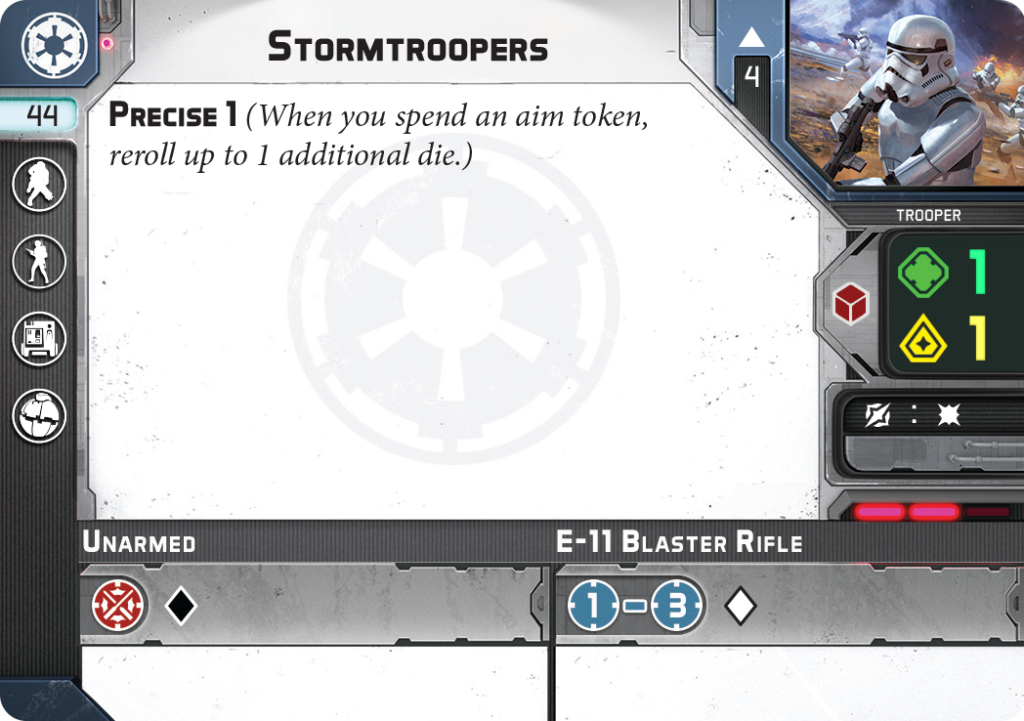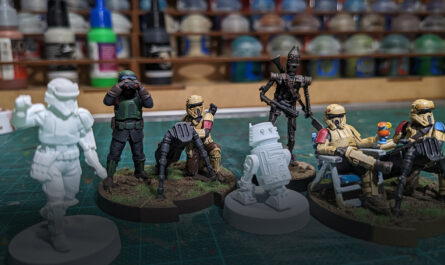When I discovered Star Wars Legion, my eyes sparkled at the sight of all those Star Wars miniatures. I envisioned myself as a general, commanding my troops to sneak between the buildings of Tatooine. I imagined them setting up ambushes, creating diversions with smoke grenades while others planted bombs—all for the greater good. Three years later, very few mines have exploded. The Stormtroopers’ visors have only suffered a few scratches, and their armor remains pristine white, much like my dice rolls. Jyn Erso and her crew have returned empty-handed countless times, without ever really getting the chance to “do Rebel stuff.” Is the Rebel Alliance the least well-designed faction in the game? I believe so, and I intend to prove it.
Welcome to the first part of “What’s Your Problem, Rebel Alliance?“, a series of articles analyzing the game design mistakes made during the creation of the Rebel Alliance in Star Wars Legion. This series is categorized under Carte blanche, meaning it represents a subjective—but well-argued—perspective aimed at providing constructive criticism.
Where’s My Rebellion?
My main criticism of the Rebel Alliance in Star Wars Legion is that its identity, as defined in the movies, has been poorly translated into the game. The actions players take to lead their troops to victory don’t align with the tactics we associate with the Rebellion’s way of fighting:
- surprise attacks
- sabotage
- explosions
- disguises
- infiltration
- sacrifice…

– How did you even find my magazines? I thought I hid them pretty well.
Has the Rebel Alliance Gone Astray in Legion?
Yes, I believe so. To justify this, we need to go back to the conception of Star Wars Legion and, more broadly, to the art of game design.
You see, in game design, there are two possible approaches for creating a game where the universe plays a significant role:
- Top-Down Design: This approach lets the game’s universe (its story, characters, etc.) dictate the game mechanics.
For example, if Darth Vader has the ability to choke his enemies using the Force, this ability will be faithfully translated into the game. On the other hand, giving C-3PO a teleportation ability would be out of the question—it wouldn’t fit the character as envisioned by George Lucas. Top-down design is ideal when immersion is the primary focus. - Bottom-Up Design: In this approach, the process is reversed—the game mechanics define the universe.
For instance, if the mechanics require a unit to have a regeneration ability, you would create or justify this feature narratively. You might invent a race of starfish-like humanoids or a magical potion that restores life. Bottom-up design is best suited when the gameplay experience takes center stage.
When adapting an existing intellectual property into a game, the process should almost always be top-down. I mention this because, in my view, some Rebel Alliance units were designed bottom-up rather than top-down. This decision creates a dissonance between the player’s expectations and the reality of the game.
But why would developers choose this approach? Part of the answer lies in the challenges of balancing an asymmetrical game.
Balancing Asymmetrical Games: A Never-Ending Puzzle
Do you know the difference between a symmetrical and an asymmetrical game? Simply put, it refers to whether a game pits identical armies or pieces against one another, and whether players have access to the same capabilities to win.
For example, chess is a symmetrical game: each player has the same number of pieces and identical abilities. Black pawns are no stronger than white pawns—aside from the fact that one color always makes the first move. By design, a symmetrical game is balanced.
In an asymmetrical game, such as Star Wars Legion, achieving balance is far trickier. Since players are no longer comparing apples to apples, how do you ensure that a given unit has equivalent value to its enemy counterpart?
One game design solution is to create reciprocals. For example, if one unit excels at offense but is weak in defense, its enemy counterpart will be weaker in attack but stronger defensively. This is exemplified by the interplay of blue and red in Magic: The Gathering, two opposing colors. If you compare the power and toughness of the creatures below, you’ll see that they are reciprocals of one another. The Leopard is built for offense, while the Merfolk excels in defense.


In the case of Star Wars Legion, Fantasy Flight Games applied the same reciprocation technique to the game’s initial two factions: the Rebel Alliance and the Empire. Stormtroopers benefited from strong defense (red defense dice), while Rebels had to make do with weaker saves (white dice). In return, the Rebels had better shooting accuracy than their Imperial counterparts.


The problem with this reciprocation technique is that it doesn’t align well with a top-down design philosophy. Why? Because by focusing too much on creating opposites, you risk making one unit no longer a faithful representation of the source material but simply a foil to its counterpart. In this scenario, game design overshadows the universe. See where I’m going?
In my opinion, that’s exactly what happened when the Imperial and Rebel base troops were created. FFG had to start by creating the Stormtroopers. As they were often seen on screen, it was easy to convey their identity, such as their inability to hit a target. Stormtroopers could only inherit offensive white dice. To counterbalance this, they were given a good defence. After all, they wear armour. Then, with the logic of reciprocity, the profile of the basic Rebels built itself. It’s as simple as generating the opposite values: the result is febrile rebels with good shooting ability. But does this result still reflect the Rebel soldiers seen in the Star Wars films?
The Alliance: Lost in the Hall of Mirrors
FFG didn’t stop at the basic troops when applying the reciprocal design approach. The developers used the same logic for certain heroes and villains. The most striking example is the comparison between General Veers and Leia Organa.


In this example, I believe FFG was once again tempted by the dark side before tackling Leia’s profile, strange as that may sound. Veers has less screen time compared to Leia. However, Leia has very few scenes where she fully embodies the role of a battlefield commander, unlike her Imperial counterpart. Even in brief moments, the Imperial General convincingly portrays his commanding role on-screen. He surveys the battlefield with binoculars and orders strikes—a perfect match for his Maximum Firepower command card and abilities like Precise 1 and Spotter 2.
Unfortunately, reciprocation logic forced the developers to give Leia the Take Cover 2 ability. But who among us associates that ability with the Princess of Alderaan?
“Remember that scene in Episode VI when she orders everyone to take cover? ! A defining moment for her !”
On the other hand, FFG got it right with Leia’s Inspire 2 ability. Her social status and unshakable conviction make her a beacon of hope and a symbol of resilience for the Rebellion. I’d even argue that her Courage value could have been set to 3 to reflect her bravery during the face-off with Vader aboard the Tantive IV.
| Were all rebel units designed bottom-up? Of course not! There are certainly Rebel units that benefited from top-down design. The actions of Fleet Troopers, for instance, are faithfully captured in Star Wars Legion. As the Tantive IV is on the verge of being boarded, the troopers rush to the exits, take cover as best they can, and point their blaster pistols at the doors, ready for the enemy’s arrival. |

A Handful of People, Really?
The actions of a small group of Rebels trying to overthrow the Empire’s overwhelming galactic power are the foundation of the original trilogy. The Empire appears to have an endless supply of Stormtrooper battalions, while for the Alliance, every life lost feels like a heavy blow.
In Star Wars Legion, however, this Alliance-Empire imbalance is not reflected. If anything, the opposite is true. Rebel lists often feature more activations than Imperial ones. Additionally, the battalion sizes are identical: a default Stormtrooper unit contains 4 troopers, the same as Rebel soldiers.
As a Rebel player, you never feel outnumbered compared to your Imperial opponent. It’s a small detail, but one that further reinforces the idea that the Rebellion’s identity has been overlooked in favor of better inter-faction balance.
Conclusion – Part One
In this first article, I wanted to warn potential Rebel players that the Alliance in Star Wars Legion is very different from what you see on the big screen. This is largely due to game design decisions, such as the questionable combination of reciprocal units and top-down design. Interestingly, this approach was not carried over to the creation of the Clone Wars factions. A tacit admission of error, perhaps?
One thing is certain: if the Rebel Alliance were created today, it would likely benefit from an entirely different approach.
Read part II

Need advice building your army list?
Join your country’s Star Wars: Legion Discord community and get answers to your questions.



